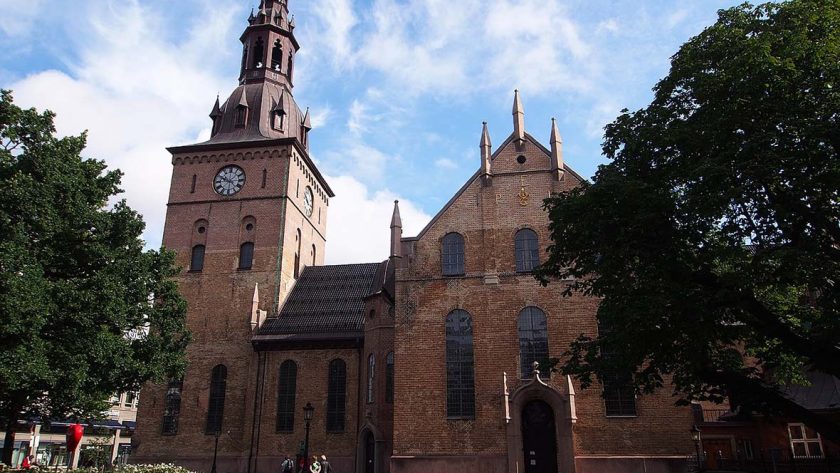Oslo, the capital of Norway, beckoned with promises of rich history and cultural treasures. Embarking on a journey through its historic sites, I found myself enchanted by the tales of the past woven into the city’s fabric. Join me as I recount my experiences at three captivating landmarks and recommend four more, each a testament to Oslo’s historical tapestry.
Exploring the Akershus Fortress
As I continued my exploration of the Akershus Fortress, each step seemed to unveil a new layer of history. The fortress, with its timeless allure, is more than just an architectural marvel; it’s a living chronicle of Norway’s resilience, its triumphs, and the challenges it has faced over the centuries.
The fortress, strategically positioned on the shores of Oslo Fjord, provides an awe-inspiring panorama of the city. The sweeping views from the ramparts offered a unique perspective, allowing me to appreciate the city’s modern skyline juxtaposed against the historical backdrop of the fortress. The coexistence of the old and the new, visible from this vantage point, symbolizes Oslo’s evolution through time.
As I delved deeper into the labyrinthine corridors, the cobbled pathways echoed with whispers of bygone eras. It was as if the stones themselves held the secrets of the past, narrating tales of medieval battles, royal intrigues, and the resilience of the Norwegian people. The architectural nuances, from the sturdy stone walls to the pointed towers, spoke volumes about the fortress’s strategic significance in protecting the city.
Unveiling Stories within Stone Walls:
The heart of the Akershus Fortress lies not just in its physical structure but in the stories etched into its stone walls. Each room seemed to have a tale of its own – from the austere chambers where medieval monarchs once deliberated to the dungeons that bore witness to the struggles of prisoners. The display of artifacts and historical exhibits further enriched the narrative, offering a tangible connection to Norway’s past.
The fortress has weathered storms, sieges, and the passage of time, emerging as a resilient symbol of the nation’s endurance. It stands as a silent witness to the ebb and flow of history, reminding visitors of the challenges faced by the people who called it home.
Strategic Significance and Military Heritage:
Beyond its aesthetic appeal, the Akershus Fortress played a crucial role in Norway’s military history. Strategically positioned to safeguard Oslo from maritime invasions, the fortress served as a formidable line of defense. Exploring the military installations within the fortress, including cannons, lookout points, and the medieval armory, provided insights into the challenges faced by those who defended the city.
The meticulous preservation of the fortress, coupled with informative plaques and guides, enhances the visitor’s understanding of its military heritage. It became evident that the strategic location of Akershus Fortress was not just about defending territory; it was a testament to the determination of the Norwegian people to protect their sovereignty.
Must-Visit for History Enthusiasts:
For history enthusiasts like myself, the Akershus Fortress is a treasure trove waiting to be discovered. The authenticity of the experience, coupled with the immersive storytelling, makes it a must-visit destination. Whether one is captivated by medieval architecture, military history, or simply the allure of the past, the fortress offers a holistic experience that transcends time.
As I concluded my journey through the Akershus Fortress, I couldn’t help but be grateful for the opportunity to step back in time and witness the echoes of Norway’s history. The fortress is not merely a static monument; it breathes life into the tales of the past and invites visitors to become part of a narrative that stretches across centuries. It stands as a testament to the enduring spirit of a nation, leaving an indelible mark on all who traverse its storied halls. The Akershus Fortress is, indeed, a captivating journey through time and an essential chapter in the vibrant tapestry of Oslo’s history.
Practical Information:
- Location: Akershus Festning, 0150 Oslo, Norway
- Admission: NOK 100 (adults), NOK 50 (children 6-18 years)
- Recommendation Index: ★★★★★
- Booking Platform: Tickets can be purchased on-site or through the official Akershus Fortress website.
Immersing in Art at the Munch Museum
A short journey from the fortress led me to the Munch Museum, dedicated to the works of the iconic Norwegian artist Edvard Munch. The museum not only housed the famous painting “The Scream” but also showcased an extensive collection of Munch’s masterpieces, providing a profound insight into his tumultuous life.
Heartfelt Reflection:
Stepping into the Munch Museum is akin to entering a sanctuary for art lovers, where the canvases come alive with the vivid emotions and contemplative brushstrokes of Edvard Munch. The museum stands as a testament to the Norwegian artist’s genius, offering an immersive journey through the depths of human experience and the evolution of his distinctive artistic style.
Carefully Curated Collection:
The heart of the Munch Museum lies in its meticulously curated collection, a treasure trove that meticulously chronicles Edvard Munch’s artistic evolution. The careful arrangement of paintings, drawings, and prints provides a chronological narrative, allowing visitors to witness the artist’s emotional and stylistic metamorphosis over the years.
Each room in the museum seemed to be a chapter in Munch’s life, with his iconic works such as “The Scream,” “The Madonna,” and “The Dance of Life” taking center stage. The juxtaposition of these masterpieces, alongside lesser-known gems, revealed the breadth and depth of Munch’s creative output.
Unveiling Emotional Depth:
Munch’s art is renowned for its profound emotional resonance, and the museum expertly captures this aspect. The paintings pulsate with raw emotions – from the angst and despair depicted in “The Scream” to the tender melancholy of “The Sick Child.” The exhibition transcends mere visual appreciation; it invites visitors to connect with the artist’s emotional journey on a visceral level.
Walking through the galleries, I found myself immersed in the haunting beauty of Munch’s exploration of love, death, and existential questions. The artist’s ability to convey the complexities of the human psyche through strokes of color and form was nothing short of mesmerizing.

Evolving Style and Techniques:
One of the museum’s highlights is its focus on Munch’s evolving style and artistic techniques. From his early works influenced by Impressionism to the later periods marked by Symbolism and Expressionism, the exhibition provides a comprehensive overview of Munch’s experimentation with form and content.
The inclusion of sketches and preparatory studies offered a glimpse into the artist’s creative process, shedding light on the meticulous planning and revisions that went into the creation of his masterpieces. It was a journey not just through finished works but also through the intimate moments of artistic genesis.
Practical Information:
- Location: Tøyengata 53, 0578 Oslo, Norway
- Admission: NOK 120 (adults), free for children under 18
- Recommendation Index: ★★★★☆
- Booking Platform: Tickets are available at the museum entrance, and online reservations can be made through their official website.
A Stroll Through Vigeland Park
Venturing further into the heart of Oslo, I found myself in the sprawling expanse of Vigeland Park. This unique outdoor sculpture park, designed by Gustav Vigeland, was a mesmerizing display of human emotion and interconnectedness. The intricately crafted statues and the lush surroundings created an atmosphere of contemplation and unity.
Heartfelt Reflection:
Vigeland Park is a testament to the power of art in public spaces. The sculptures, each telling a different story, invite visitors to reflect on the human experience. The park is a serene retreat within the bustling city.
Practical Information:
- Location: Nobels gate 32, 0268 Oslo, Norway
- Admission: Free
- Recommendation Index: ★★★★★
- Booking Platform: No reservation needed for park entry.
Recommendations:
The Royal Palace: Regal Grandeur in the Heart of Oslo
The Royal Palace, situated at the end of Karl Johans gate, is a majestic symbol of Norway’s monarchy. The changing of the guards is a spectacle not to be missed, and the palace grounds offer a picturesque setting for a leisurely stroll. Practical Information:
- Location: Slottsplassen 1, 0010 Oslo, Norway
- Admission: Exterior and Palace Park are free; guided tours available at NOK 150 (adults), NOK 50 (children)
- Recommendation Index: ★★★★☆
- Booking Platform: Guided tours can be booked on the official Royal Palace website.
Holmenkollen Ski Museum and Tower: A Thrilling Nordic Experience
For a taste of Oslo’s adventurous spirit, I headed to the Holmenkollen Ski Museum and Tower. The museum delves into the history of skiing, while the tower offers breathtaking views of the city and the surrounding fjords. Practical Information:
- Location: Kongeveien 5, 0787 Oslo, Norway
- Admission: NOK 160 (adults), NOK 80 (children 6-15 years)
- Recommendation Index: ★★★★☆
- Booking Platform: Tickets can be purchased on-site or online through the official website.
Oslo Cathedral: A Spiritual Haven in the City Center
Nestled in the heart of Oslo, the Oslo Cathedral is a spiritual and architectural gem. The serene ambiance inside, coupled with the intricate stained glass windows, makes it a peaceful retreat from the city buzz. Practical Information:
- Location: Stortorvet 1, 0155 Oslo, Norway
- Admission: Free
- Recommendation Index: ★★★☆☆
- Booking Platform: No reservation needed for cathedral visits.
Oslo’s historic allure is a captivating tapestry woven with tales of resilience, artistry, and cultural richness. The landmarks explored and recommended each contribute to the city’s narrative in their unique way, inviting visitors to embark on a journey through time. As I reflect on these experiences, I am left with a profound appreciation for Oslo’s commitment to preserving its heritage while embracing the spirit of modernity. My journey continues, fueled by the curiosity to uncover more of the world’s treasures.



